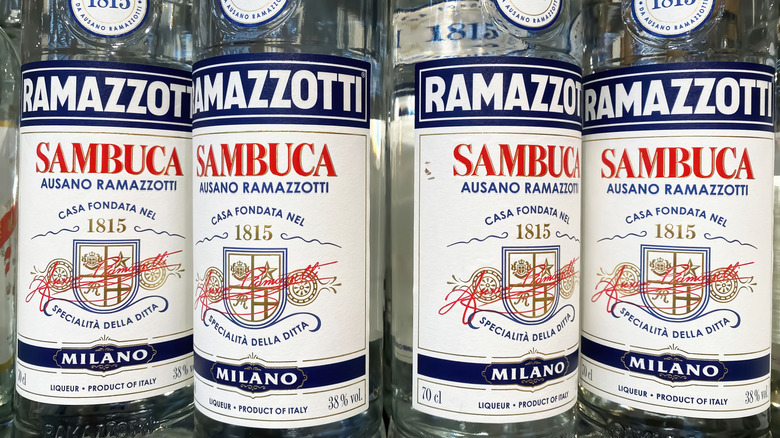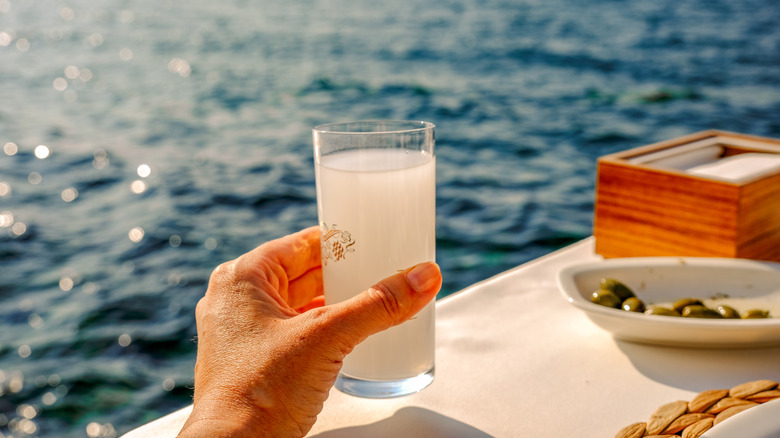What Separates Sambuca From Ouzo?
Alcohols turn to a wide variety of ingredients for flavor. And especially in Europe, a common flavoring is anise. Whether it's the star anise fruit, or the seeds of the Pimpinella anisum plant, it's the contained herbaceous oil that melds with booze so well. Absinthe — which needs to be drunk with a slotted spoon — is an especially famed take on the style, but it's just the tip of the iceberg.
The range of anise spirits is further showcased by sambuca and ouzo. Although the two booze styles are defined by the inclusion of the aromatic spice, their other qualities are disparate. Sambuca is in the liqueur category; its character is defined by the large amount of sugar in its composition. Such a quality makes it fitting for a post-meal context, often enjoyed alongside coffee or in a mixed drink.
Meanwhile, ouzo's boldness manifests in a drier, more herbal manner. Most commonly diluted with ice, this drink bears a stronger resemblance to spirits. The boozy, yet pleasant flavor pairs well with savory foods, making it a favorite drink before dinner. There are specific contexts — and delights — to each, so it's worthwhile to procure a bottle of both for the liquor shelf.
What is sambuca?
Hailing from Italy, sambuca is an anise-flavored liqueur, meaning it's heavy on both sugar and herbal flavors. Clear in color, the bottle may seem to blend in along with other alcohols, but it offers an especially pungent taste. The majority of its flavor is derived from either star anise or green anise seeds. These notes are then complemented with variable spice additions like cloves, fennel, cinnamon, coriander, elderflower, and dill extract. The palate typically turns dominantly licorice-like, but with occasional spice and heat in the background. And there's still enough booze to still inspire a burn: The liqueur runs 38% abv.
Due to the contained anise oil, the sambuca turns opaque, a quality that can be advantageous to imbue drinks with a nice hue. And its usability in mixed cocktails is furthered with the viscous nature, making it malleable like other liqueurs. As a result, sambuca is consumed in many contexts: on its own, alongside coffee (with which it melds especially well), as well as neat in chilled format.
What is ouzo?
Bold, herbal, yet sippable, ouzo is Greece and Cyprus's beloved anise-flavored spirit. Its distillation base is grape pomace — a remnant of wine production, the ingredient similarly makes grappa different from other brandy. Yet in this liquor, the flavors of the fruit and spice produce a drink equal parts refreshing and strong. Rather than quickly downing, it's made to relish on ice at the start of the meal.
Anise seeds are the most predominant flavoring, defining the liquor's licorice-like palate. It's this seed's oils that are responsible for ouzo's louche effect: the liquor's transformation to a milky white when mixed with water. And there are also often further flavors, which depend on the manufacturer. Distillers reach from an expansive array of spices like cloves, cinnamon, cardamom, coriander, peppermint, and star anise. Plus, plants like angelica root, ginger, fennel, mint, as well as mastic — a tree resin — are distilled into ouzo.
Despite such possible flavorings, most ouzos have a relatively similar taste. Anise, sweetness and spirituous notes dominate the palate, with the other herbal flavors working in complement. Nevertheless, ouzo distilleries craft secretive ingredient mixes, which slightly differentiate the spirit between bottles. The strength varies, too — from 37.5% to 45% ABV. So, although nearly all ouzos provide a similar experience, there's nuance in the details.
European Union regulation controls both alcohols
The two spirit styles hail from distinct Mediterranean cultures, with European Union regulation in place for each type. Sambuca's connected to Italy, but doesn't have geographic protection. Instead, there are legal parameters on the liqueur contents, like the inclusion of anise, at least 350 milligrams of sugar in a liter, and at least 38% ABV, as outlined in the Official Journal of the European Union published in 2008.
For ouzo, production is limited to exclusively Greece and Cyprus. The alcohol comes with two forms of regulated protection. First, there's the Protected Designation of Origin, which recognizes areas for ouzo production. Regional rights are further strengthened with Protected Geographical Indication, which serves to prohibit the sale of other alcohols with the ouzo label.
The specifics of the ouzo liquor are overseen by Greek rather than European Union law. As outlined by the Greek Federation of Spirit Producers, ouzo must be at a minimum of 37.5% ABV, be crafted on a copper still distilling under 1,000 liters, and possess a maximum of 50 grams of sugar per liter. The spirit also comes with different substyles, which differ based on the initial pomace, added flavorings, and the distillation style. The European Union grants geographic indications to specific regions of ouzo production, like Macedonia, Thrace, and others.
The two drinks are consumed in different ways
As a traditional Greek drink, ouzo carries a designated ritual of consumption. Ouzo is enjoyed poured into a tall glass — called a kanoakia — combined with a small amount of ice for both dilutions, and to activate the opaque-coloring. Enjoyed as an apéritif rather than digestif, it's consumed alongside a diversity of meze, like grilled octopus, dolma, and fried saganaki cheese. The anise and boozy flavors complement the food, so it's rare to mix ouzo with other ingredients. Some might mesh the anise notes with lemon and mint, but ouzo isn't generally found in a cocktail context.
Sambuca's also often enjoyed neat, analogously served over ice to inspire cloudiness. As opposed to ouzo, it's designated after a meal, oftentimes alongside dessert and shots of espresso. Its complementing nature with coffee is evinced by a ritual called sambuca con la mosca — translated to with the fly — which entails several coffee beans placed in the glass.
Furthermore, sambuca is employed in a range of delicious Italian-inspired cocktails. With its liqueur-like quality, sambuca meshes well with many spirits, making it a versatile bar cart addition. Its anise-forward flavor can emulate absinthe in a Sazerac, but with a lower alcoholic content. And the palate mingles with notes of fruit, meshing with everything from vibrant syrups to rum. Not to mention the sambuca's sweetness can shine in a dessert setting, adding a boozy twist to everything from fruit to a milkshake.




